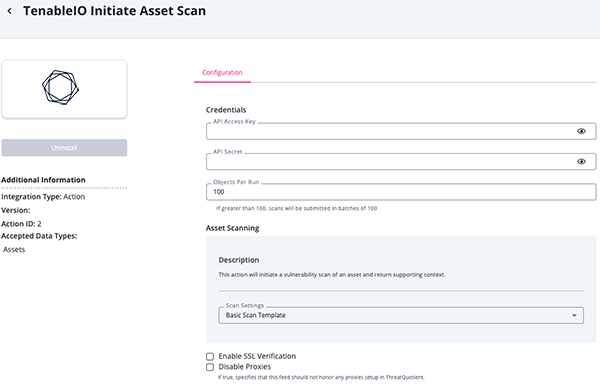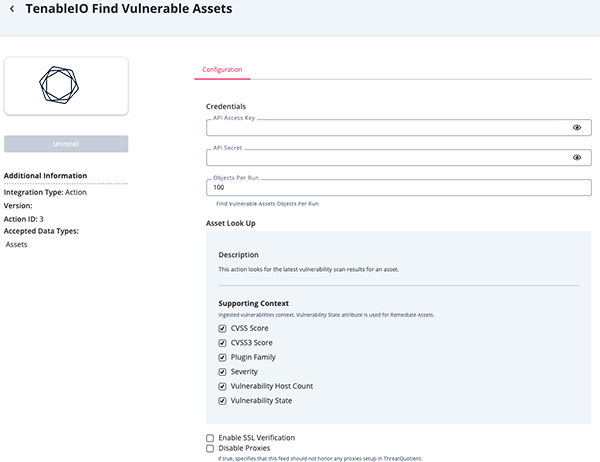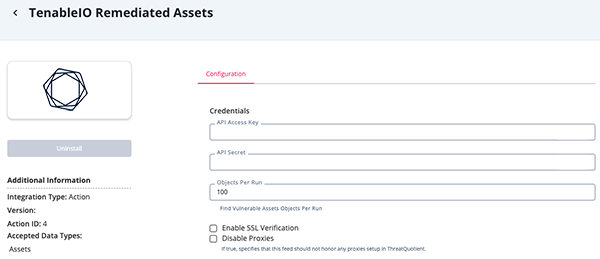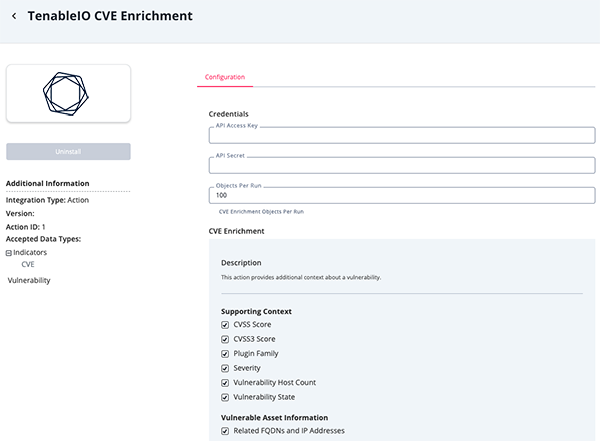Tenable.io Action Bundle
The web format of this guide reflects the most current release. Guides for older iterations are available in PDF format.
Integration Details
ThreatQuotient provides the following details for this integration:
| Current Integration Version | 1.2.0 |
| Compatible with ThreatQ Versions | >= 5.25.0 |
| ThreatQ TQO License Required | Yes |
| Compatible with Tenable.io API Versions | >= 6.4.0 |
| Support Tier | ThreatQ Supported |
Introduction
The actions included with the Tenable.io Action Bundle integrate with the Tenable.io API and provide visibility into the assets and vulnerabilities for an organization. The actions can run scans to identify vulnerabilities and submit data from a collection to retrieve vulnerability data for ingestion into the ThreatQ library.
The action bundle provides the following actions:
- Tenable.io Initiate Asset Scan - submits a list of FQDN / IP Addresses Assets to initiate a vulnerability scan.
- Tenable.io Find Vulnerable Assets - retrieves latest vulnerability scan results for FQDN / IP Addresses Assets.
- Tenable.io Remediated Assets - retrieves latest vulnerability scan results for FQDN / IP Address Assets and unrelates the ones that are related to the Asset, but are not vulnerable anymore.
- Tenable.io CVE Enrichment - enriches a CVE with additional context and assets.
The actions are compatible with the following system object types:
- Assets
- Indicators
- CVE
- Vulnerabilities
The actions return the following enriched system objects:
- Assets
- Indicators
- CVE
- Vulnerabilities
This action is intended for use with ThreatQ TDR Orchestrator (TQO). An active TQO license is required for this feature.
Prerequisites
- A Tenable.io API Access Key and Secret Key.
- An active ThreatQ TDR Orchestrator (TQO) license.
- A data collection containing at least one the following object types:
- Assets
- Indicators
- CVE
- Vulnerabilities
Installation
Perform the following steps to install the integration:
The same steps can be used to upgrade the integration to a new version.
- Log into https://marketplace.threatq.com/.
- Locate and download the action bundle zip file.
- Navigate to the integrations management page on your ThreatQ instance.
- Click on the Add New Integration button.
- Upload the zip file using one of the following methods:
- Drag and drop the zip file into the dialog box
- Select Click to Browse to locate the zip file on your local machine
- Select the individual actions to install and click Install.
ThreatQ will inform you if the action already exists on the platform and will require user confirmation before proceeding. ThreatQ will also inform you if the new version of the action contains changes to the user configuration. The new user configurations will overwrite the existing ones for the action and will require user confirmation before proceeding.
- The actions will be added to the integrations page. You will still need to configure the action.
Configuration
ThreatQuotient does not issue API keys for third-party vendors. Contact the specific vendor to obtain API keys and other integration-related credentials.
To configure the integration:
- Navigate to your integrations management page in ThreatQ.
- Select the Actions option from the Category dropdown (optional).
- Click on the action entry to open its details page.
- Enter the following parameters under the Configuration tab:
The configurations set on this page will be used as the default settings when inserting this action into a new workflow. Updating the configurations on this page will not update any instances of this action that have already been deployed to a workflow. In that scenario, you must update the action’s configurations within the workflow itself.
Initiate Asset Scan Parameters
Parameter Description API Access Key Your Tenable Access Key. This key can be generated under the Generate API Key section of the Tenable.io account settings. API Secret Your Tenable API Secret. This can be generated under the Generate API Key section of the Tenable.io account settings. Object Per Run The Maximum number of objects to submit per workflow run. The max value for this parameter is 50,000. Scan Settings Select a Scan Setting template to initiate a vulnerability scan of the asset and return support content. Options include Basic Scan Template (default) and Custom. Scan Template ID Enter a Scan ID Template. This parameter is only accessible if the Customoption is selected for the Scan Settings parameter.Enable SSL Verification When enabled, the action validates the host-provided SSL certificate. This option is enabled by default. Disable Proxies Enable this parameter if the action should not honor the proxies set in ThreatQ. 
Find Vulnerable Assets Parameters
Parameter Description API Access Key Your Tenable Access Key. This key can be generated under the Generate API Key section of the Tenable.io account settings. API Secret Your Tenable API Secret. This can be generated under the Generate API Key section of the Tenable.io account settings. Object Per Run The Maximum number of objects to submit per workflow run. The max value for this parameter is 50,000. Supporting Context Select the supporting attributes context to ingest for the Vulnerability. Options include: - CVSS Score
- CVSS3 Score
- Plugin Family
- Severity
- Vulnerability Host Count
- Vulnerability State
Enable SSL Verification When enabled, the action validates the host-provided SSL certificate. This option is enabled by default. Disable Proxies Enable this parameter if the action should not honor the proxies set in ThreatQ.

Remediated Assets Parameters
Parameter Description API Access Key Your Tenable Access Key. This key can be generated under the Generate API Key section of the Tenable.io account settings. API Secret Your Tenable API Secret. This can be generated under the Generate API Key section of the Tenable.io account settings. Object Per Run The Maximum number of objects to submit per workflow run. The max value for this parameter is 50,000. Enable SSL Verification When enabled, the action validates the host-provided SSL certificate. This option is enabled by default. Disable Proxies Enable this parameter if the action should not honor the proxies set in ThreatQ. 
CVE Enrichment Parameters
Parameter Description API Access Key Your Tenable Access Key. This key can be generated under the Generate API Key section of the Tenable.io account settings. API Secret Your Tenable API Secret. This can be generated under the Generate API Key section of the Tenable.io account settings. Object Per Run The Maximum number of objects to submit per workflow run. The max value for this parameter is 50,000. Supporting Context Select the supporting attributes context to ingest for Vulnerability. Options include: - CVSS Score
- CVSS3 Score (default)
- Plugin Family
- Severity (default)
- Vulnerability Host Count
- Vulnerability State (default)
Vulnerable Asset Information Enable this parameter for CVE enrichment of Related FQDNs and IP Addresses. Enable SSL Verification When enabled, the action validates the host-provided SSL certificate. This option is enabled by default. Disable Proxies Enable this parameter if the action should not honor the proxies set in ThreatQ.

- Review any additional settings, make any changes if needed, and click on Save.
Actions
The bundle provides the following actions:
| action | Description | Object Type | Object Subtype |
|---|---|---|---|
| Initiate Asset Scan | Trigger a new scan for a list of indicators. | Assets | N/A |
| Find Vulnerable Assets | Retrieves latest vulnerability scan results. | Assets | N/A |
| CVE Enrichment | Enrich CVE indicators with vulnerabilities. | Indicator, Vulnerability | Indicators - CVE |
| Remediated Assets | Unrelates vulnerabilities that are not present in latest scan results | Assets | N/A |
Initiate Asset Scan
The Initiate Asset Scan action triggers a scan on the Tenable.io platform. It starts by creating the scan using the Basic Network Scan Template and default settings or a custom template. Once the scan exists on the platform, it will grab the id of the scan and it will trigger the launch of the scan with Indicator values from the collection.
Scan
POST "https://cloud.tenable.com/scans"
Sample Response:
{
"scan": {
"container_id": "3584b24b-7f26-4684-b644-a2a92103d6c2",
"owner_uuid": "595e5aa0-e631-4e99-80e2-e1be8cc7bdc1",
"uuid": "template-8b64a4a8-50b4-4077-bcc4-31f451fa3549f4f660ba792e0b0f",
"name": "Full Network Scan",
"description": "Scan all hosts daily",
"policy_id": 16,
"scanner_id": null,
"scanner_uuid": "00000000-0000-0000-0000-00000000000000000000000000001",
"emails": null,
"sms": "",
"enabled": true,
"dashboard_file": null,
"include_aggregate": true,
"scan_time_window": null,
"custom_targets": null,
"starttime": null,
"rrules": null,
"timezone": "US/Central",
"notification_filters": null,
"tag_targets": [
"1cf4f3a3-9878-44ce-9fa7-3a969c602e28",
"9808942a-2053-43a7-8580-7caebdfb959f"
],
"shared": 0,
"user_permissions": 128,
"default_permissions": 0,
"owner": "user2@example.com",
"owner_id": 2,
"last_modification_date": 1544145190,
"creation_date": 1544145190,
"type": "public",
"id": 26
}
}
Launch
POST "https://cloud.tenable.com/scans/{{scan_id}}/launch"
Sample Response:
{
"scan_uuid": "44346bcb-4afc-4db0-b283-2dd823fa8579"
}Find Vulnerability Assets
The TenableIO Find Vulnerable Assets action submits a FQDN/IP address Assets to Tenable.io in order to obtain vulnerability data. This data is added as attributes for the submitted assets. All attributes are updatable.
GET "https://cloud.tenable.com/workbenches/vulnerabilities?filter.0.filter=host.target&filter.0.quality=match&filter.0.value={{host}}"
Sample Response:
{
"vulnerabilities": [
{
"count": 20,
"plugin_family": "General",
"plugin_id": 51192,
"plugin_name": "SSL Certificate Cannot Be Trusted",
"vulnerability_state": "Resurfaced",
"accepted_count": 0,
"recasted_count": 0,
"counts_by_severity": [
{
"count": 20,
"value": 2
}
],
"cvss_base_score": 6.4,
"cvss3_base_score": 6.5,
"severity": 2
}
]
}ThreatQuotient provides the following default mapping for this action:
| Feed Data Path | ThreatQ Entity | ThreatQ Object Type or Attribute Key | Published Date | Examples | Notes |
|---|---|---|---|---|---|
| .vulnerabilities[].plugin_name | vulnerability.value | Vulnerability | N/A | SSL Certificate Cannot Be Trusted | N/A |
| .vulnerabilities[].plugin_family | vulnerability.attribute | Plugin Family | N/A | General | User-configurable; Updatable |
| .vulnerabilities[].vulnerability_state | vulnerability.attribute | Vulnerability State | N/A | Resurfaced | User-configurable; Updatable |
| .vulnerabilities[].count | vulnerability.attribute | Vulnerable Hosts Count | N/A | 51 | User-configurable; Updatable |
| .vulnerabilities[].cvss_base_score | vulnerability.attribute | CVSS Base Score | N/A | 6.4 | User-configurable; Updatable |
| .vulnerabilities[].cvss3_base_score | vulnerability.attribute | CVSS3 Base Score | N/A | 6.5 | User-configurable; Updatable |
| .vulnerabilities[].severity | vulnerability.attribute | Severity | N/A | 2 | User-configurable; Updatable |
CVE Enrichment
The CVE Enrichment action pushes each CVEs vulnerabilities or indicators to the Tenable.io platform where it will search vulnerabilities that match a target host. If there's a match, then it will pull the vulnerabilities and ingest them, otherwise it won't perform any action. Optionally, this action also has the ability to pull in any assets found to have vulnerabilities that are related to the specified CVE.
GET "https://cloud.tenable.com/workbenches/vulnerabilities?filter.0.filter=plugin.attributes.cve.raw&filter.0.quality=eq&filter.0.value={{cve}}"
Sample Response:
{
"vulnerabilities": [
{
"count": 1,
"plugin_family": "Misc.",
"plugin_id": 143221,
"plugin_name": "ESXi 6.5 / 6.7 / 7.0 Multiple Vulnerabilities (VMSA-2020-0026)",
"vulnerability_state": "Active",
"vpr_score": 6.5,
"severity": 3,
"accepted_count": 0,
"recasted_count": 0,
"counts_by_severity": [
{
"count": 1,
"value": 3
}
],
"cvss_base_score": 7.2,
"cvss3_base_score": 8.2
}
],
"total_vulnerability_count": 1,
"total_asset_count": 0
}ThreatQuotient provides the following default mapping for this action:
| Feed Data Path | ThreatQ Entity | ThreatQ Object Type or Attribute Key | Published Date | Examples | Notes |
|---|---|---|---|---|---|
| .vulnerabilities[].plugin_name | vulnerability.value | Vulnerability | N/A | SSL Certificate Cannot Be Trusted | N/A |
| .vulnerabilities[].plugin_family | vulnerability.attribute | Plugin Family | N/A | General | User-configurable; Updatable |
| .vulnerabilities[].vulnerability_state | vulnerability.attribute | Vulnerability State | N/A | Resurfaced | User-configurable; Updatable |
| .vulnerabilities[].count | vulnerability.attribute | Vulnerable Hosts Count | N/A | 51 | User-configurable; Updatable |
| .vulnerabilities[].cvss_base_score | vulnerability.attribute | CVSS Base Score | N/A | 6.4 | User-configurable; Updatable |
| .vulnerabilities[].cvss3_base_score | vulnerability.attribute | CVSS3 Base Score | N/A | 6.5 | User-configurable; Updatable |
| .vulnerabilities[].severity | vulnerability.attribute | Severity | N/A | 2 | User-configurable; Updatable |
Optionally, this action also has the ability to pull in any assets found to have vulnerabilities that are related to the specified CVE.
GET https://cloud.tenable.com/workbenches/assets/vulnerabilities?filter.0.filter=plugin.attributes.cve.raw&filter.0.quality=eq&filter.0.value={{cve}}
Sample Response:
{
"assets": [
{
"id": "f60e219b-f8d9-481f-8dac-cfaf511bdf91",
"severities": [
{
"count": 0,
"level": 0,
"name": "Info"
}
],
"total": 1,
"fqdn": ["example.com"],
"ipv4": [
"192.168.1.20"
],
"ipv6": [],
"last_seen": "2024-09-17T19:40:12.204Z",
"netbios_name": [],
"agent_name": []
}
],
"total_asset_count": 1
}| Feed Data Path | ThreatQ Entity | ThreatQ Object Type or Attribute Key | Published Date | Examples | Notes |
|---|---|---|---|---|---|
| .assets[].fqdn[], assets[].ipv4[] | related asset.value | Asset | N/A | example.com(192.168.1.20) | User-configurable |
| .assets[].ipv4 | asset.attribute | IP Address | N/A | 192.168.1.20 | N/A |
| .assets[].fqdn | asset.attribute | FQDN | N/A | example.com | N/A |
Remediated Assets
The TenableIO Remediated Assets action submits a FQDN/IP address Assets to Tenable.io in order to obtain latest vulnerability data. If the Assets has related Vulnerabilities in TQ that are not found in latest results, then the Vulnerability is unrelated and the Vulnerability State attribute is set to Fixed.
GET "https://cloud.tenable.com/workbenches/vulnerabilities?filter.0.filter=host.target&filter.0.quality=eq&filter.0.value={{host}}"
Sample Response:
{
"vulnerabilities": [
{
"count": 20,
"plugin_family": "General",
"plugin_id": 51192,
"plugin_name": "SSL Certificate Cannot Be Trusted",
"vulnerability_state": "Resurfaced",
"accepted_count": 0,
"recasted_count": 0,
"counts_by_severity": [
{
"count": 20,
"value": 2
}
],
"cvss_base_score": 6.4,
"cvss3_base_score": 6.5,
"severity": 2
}
]
}ThreatQuotient provides the following default mapping for this action:
| Feed Data Path | ThreatQ Entity | ThreatQ Object Type or Attribute Key | Published Date | Examples | Notes |
|---|---|---|---|---|---|
| N/A | vulnerability.attribute | Vulnerability State | N/A | Fixed |
Updatable; Attribute is set to Fixed only when it is unrelated from the Asset |
Enriched Data
Object counts and action runtime are supplied as generalities only - objects returned by a provider can differ based on credential configurations and action runtime may vary based on system resources and load.
Initiate Asset Scan
| Metric | Result |
|---|---|
| Run Time | 1 minute |
| Assets | 3 |
| Asset Attributes | 3 |
Find Vulnerable Assets
| Metric | Result |
|---|---|
| Run Time | 1 minute |
| Assets | 4 |
| Vulnerabilities | 36 |
| Vulnerability Attributes | 211 |
Remediated Assets
| Metric | Result |
|---|---|
| Run Time | 1 minute |
| Vulnerabilities | 33 |
| Vulnerability Attributes | 33 |
CVE Enrichment
| Metric | Result |
|---|---|
| Run Time | 1 minute |
| Indicators | 2 |
| Assets | 1 |
| Asset Attributes | 1 |
| Vulnerabilities | 5 |
| Vulnerability Attributes | 18 |
Known Issues / Limitations
- No more than 5,000 vulnerabilities can be retrieved at once
- It only retrieves vulnerabilities less than 15 months old
- No more than 10,000 scan can be created
Change Log
- Version 1.2.0
- Added a new action: Tenable.io Remediated Assets.
- Updated Initiate Asset Scan and Find Vulnerable Assets actions to accept Assets instead of indicators.
- Updated the search to only retrieve exact matches instead of substring matches for TenableIO Find Vulnerable Asset feed.
- Updated the TenableIO CVE Enrichment action to accept collection of CVE Vulnerabilities or Indicators and to ingest related FQDN/IP Addresses as Assets instead of Indicators.
- Updated the minimum ThreatQ version to 5.25.0.
- Version 1.1.0
- Bulk scans are now supported.
- Updated minimum ThreatQ version to 5.12.1.
- The provider's logo will now appear in the action details view of ThreatQ, as well as the Workflow builder, if you install the action bundle using the zip file provided by the ThreatQ Marketplace.
- Version 1.0.0
- Initial release
PDF Guides
| Document | ThreatQ Version |
|---|---|
| Tenable.io Action Bundle Guide v1.2.0 | 5.25.0 or Greater |
| Tenable.io Action Bundle Guide v1.1.0 | 5.12.1 or Greater |
| Tenable.io Action Guide v1.0.0 | 5.6 or Greater |